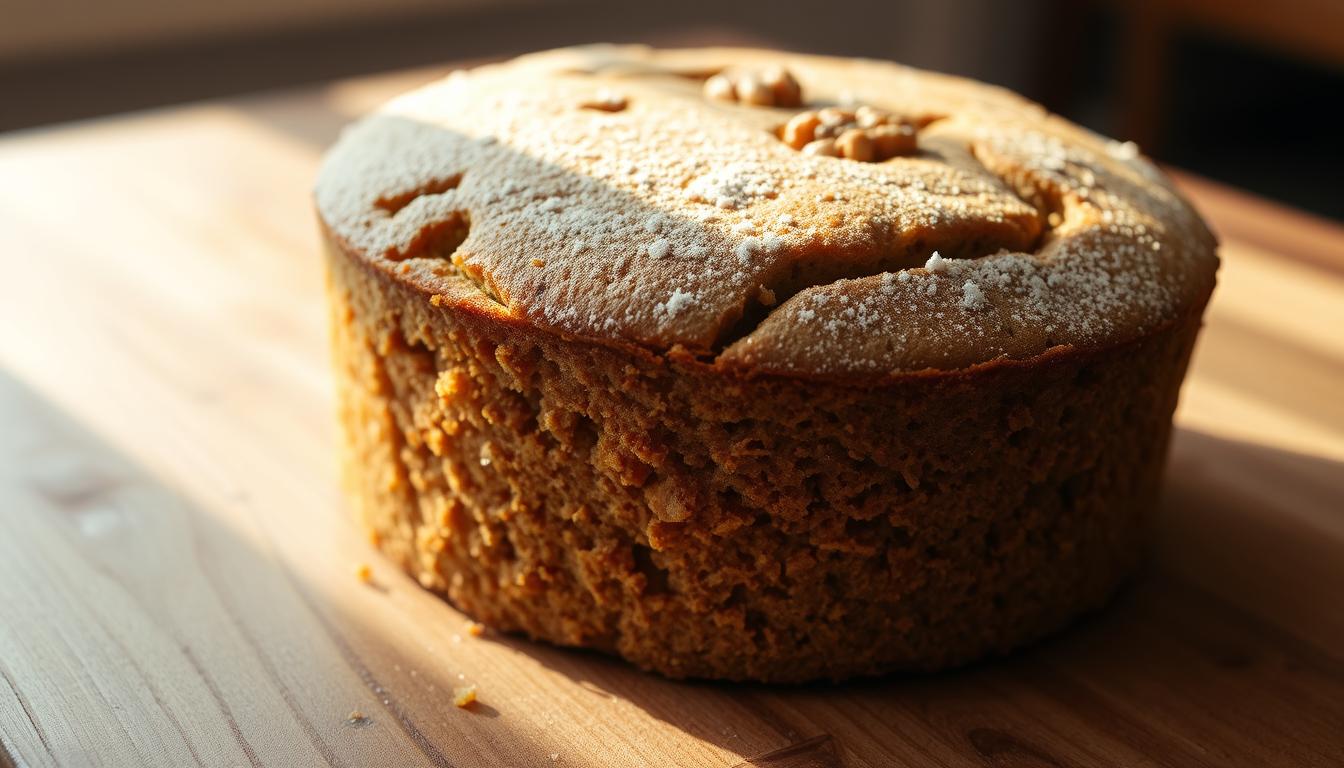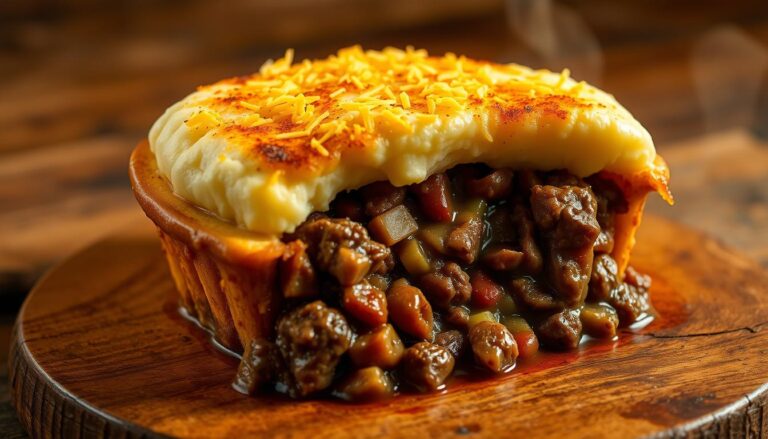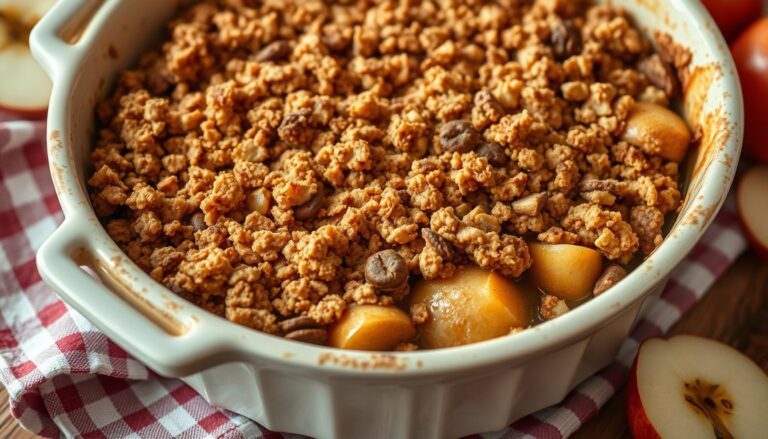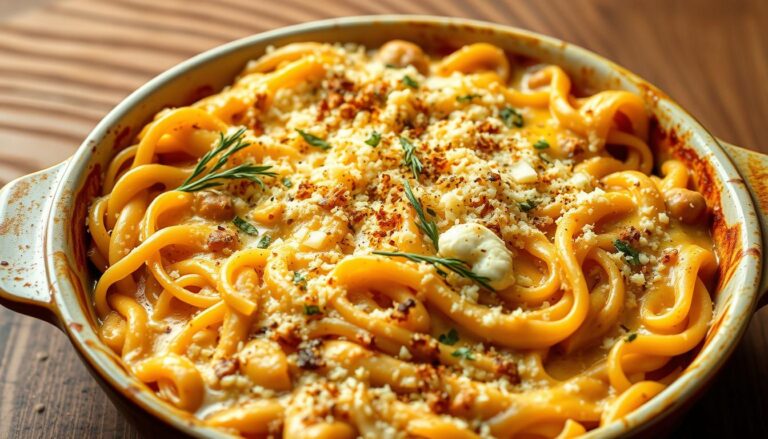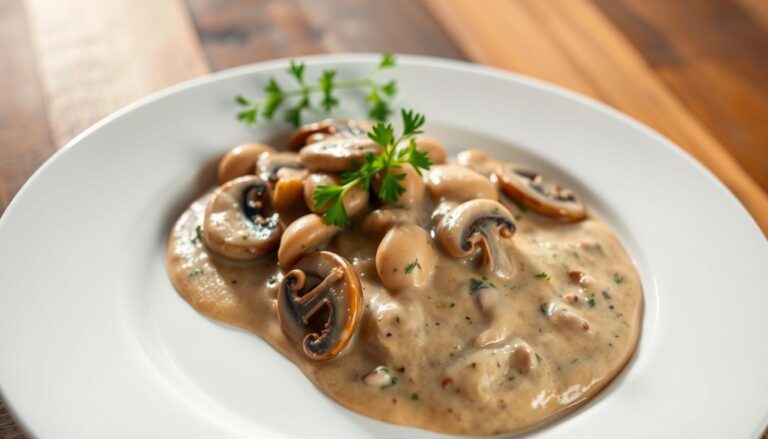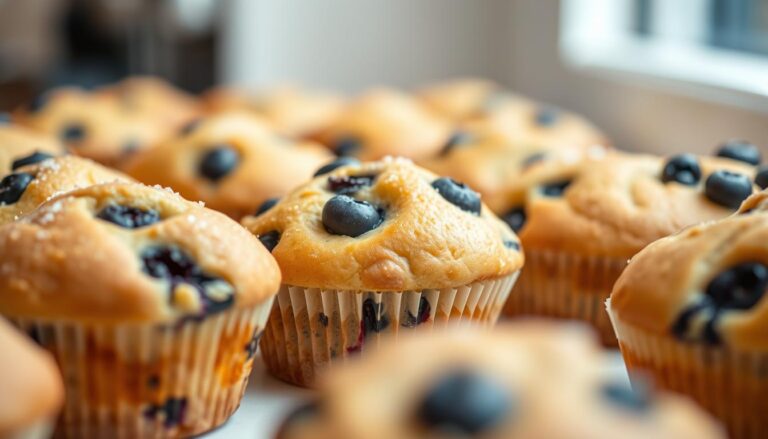Delicious Carrot Cake Recipe: Moist, Flavorful, and Easy to Make
Enjoy the sweet treat of a homemade carrot cake that’s both moist and tasty. This classic dessert is loved by many. It’s easy to make and always a hit with everyone.
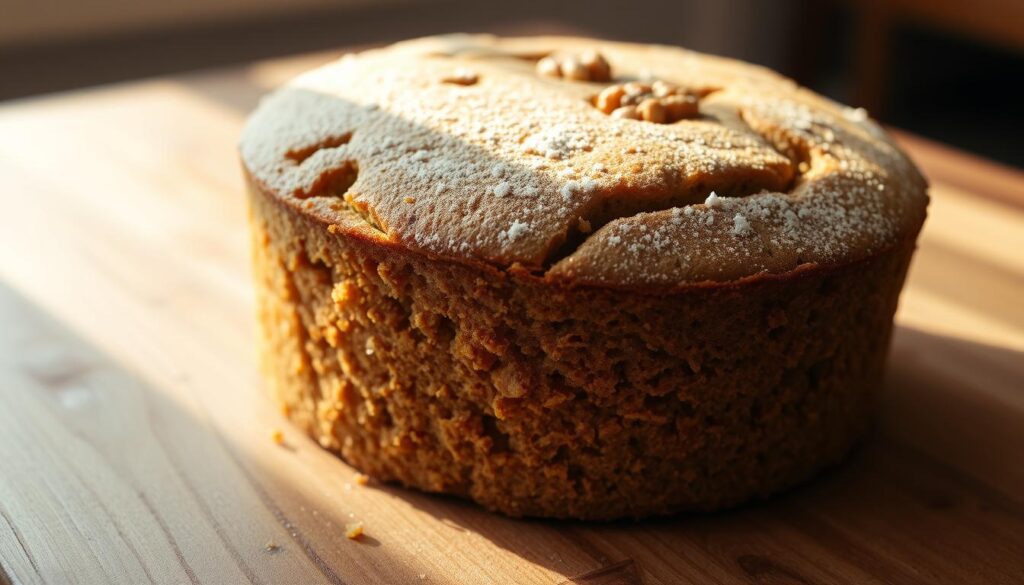
By making a carrot cake from scratch, you can pick the ingredients. This means it can be as delicious as you like. With just a few simple ingredients and easy steps, you can make a best moist carrot cake recipe. It’s sure to become a favorite in your family.
Key Takeaways
- Easy to make from scratch
- Moist and flavorful texture
- Customizable ingredients
- Perfect for any occasion
- A classic dessert that’s always a hit
The History and Appeal of Carrot Cake
Carrot cake’s history is as layered as the dessert itself. It goes back to medieval Europe. Carrots were used in sweet dishes because sugar was scarce and expensive.
Origins of Carrot Cake
The origins of carrot cake are tied to the Middle Ages. Carrots were used as a sweetener because sugar was too expensive. This was common in Europe, especially in England and France.
When trade routes grew and sugar became easier to get, carrot cake changed. It started using spices and other ingredients that were once rare.
| Period | Characteristics | Notable Ingredients |
|---|---|---|
| Medieval | Use of carrots as sweetener | Carrots, spices |
| 17th-18th Century | Incorporation of sugar and spices | Sugar, cinnamon, nutmeg |
| Modern | Diverse variations | Nuts, raisins, cream cheese frosting |
Why Carrot Cake Remains a Beloved Dessert
Carrot cake is loved for its moist texture and depth of flavor. Spices and other ingredients add to its taste. The cream cheese frosting also makes it a favorite.
Carrot cake is versatile, allowing for many variations and dietary changes. This makes it a favorite among dessert lovers.
Essential Ingredients for the Perfect Carrot Cake
To make a moist and flavorful carrot cake, choose the best ingredients. The quality of your cake depends on the freshness and type of ingredients. This section will guide you through the essential components for a delicious carrot cake.
Fresh Produce Components
Fresh produce is key in carrot cake. Carrots, the main ingredient, should be fresh and juicy. You’ll need about 2 cups of grated carrots. Fresh pineapple and walnuts or pecans add flavor and texture. Make sure your produce is fresh for the best taste.
Dry Ingredients
Dry ingredients give your cake structure. You’ll need all-purpose flour, baking powder, baking soda, salt, and spices like cinnamon and nutmeg. The right mix of these ingredients is crucial for a balanced flavor and texture.
Wet Ingredients
Wet ingredients add moisture and richness. You’ll need granulated sugar, eggs, vegetable oil, and vanilla extract. The quality of these ingredients greatly affects your cake’s moisture and flavor. Using room temperature eggs, for example, helps create a smoother batter.
Kitchen Tools and Equipment You’ll Need
Before you start baking your carrot cake, it’s crucial to have the right kitchen tools and equipment. Having everything you need will make the baking process smoother and more enjoyable.
Baking Essentials
You’ll need some basic baking tools to start. A 9-inch round cake pan is perfect for baking a standard-sized carrot cake. You’ll also need a mixing bowl set for mixing your ingredients.
A whisk and a rubber spatula are key for mixing and scraping the sides of your bowls. And, a digital kitchen scale is vital for accurately measuring your ingredients.
Optional but Helpful Tools
While not essential, some tools can make baking easier and more efficient. A food processor is great for grating carrots and mixing wet ingredients. A stand mixer is also useful for creaming butter and sugar, and beating eggs.
For a more evenly baked cake, consider using a cake leveler.
| Tool | Purpose |
|---|---|
| 9-inch round cake pan | Baking the carrot cake |
| Mixing bowl set | Combining ingredients |
| Whisk | Mixing wet ingredients |
| Rubber spatula | Scraping bowl sides |
| Digital kitchen scale | Measuring ingredients accurately |
Preparing Your Ingredients
Getting your ingredients ready is key to a moist and tasty carrot cake. This step, called “mise en place,” means having everything measured and ready before you start mixing. It makes baking easier and more fun.
Grating Carrots: Techniques and Tips
Grating carrots is a big deal for your cake’s texture and taste. There are a few ways to grate carrots, each with its own benefits.
Hand Grating vs. Food Processor
Hand grating lets you control the carrot texture, from coarse to fine. But, using a food processor is faster and better for big batches. Just be careful not to turn the carrots into pulp.
Achieving the Perfect Texture
The best carrot grate is fine but not too soft. This ensures carrots are spread out well in the batter. Every bite should have a good mix of cake and carrot. Use a shredding attachment or a box grater to get this right.
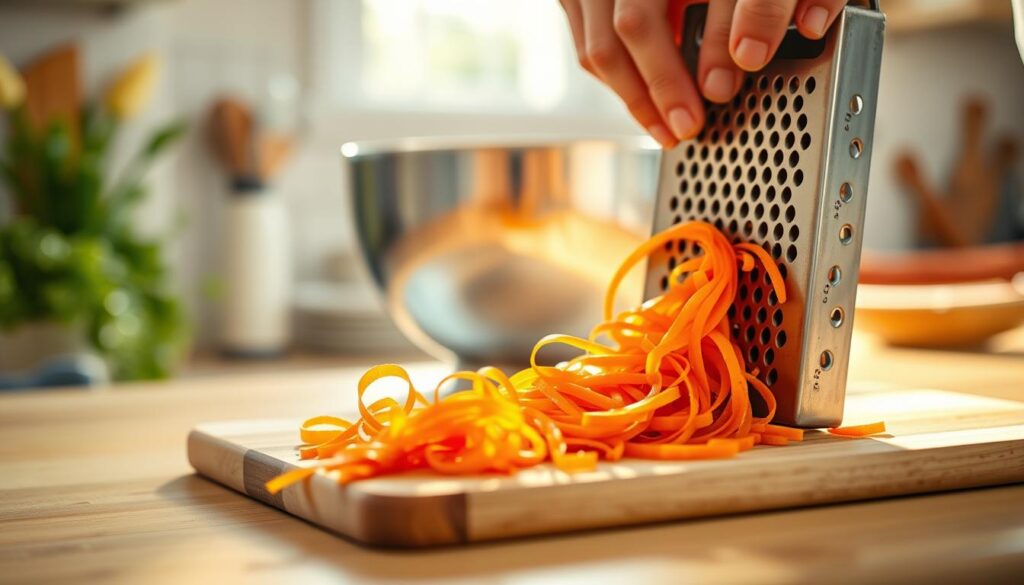
Measuring and Organizing Your Mise en Place
Measuring ingredients right is crucial in baking. Use a digital scale for dry stuff like flour and sugar. Wet ingredients go in measuring cups. Arrange your ingredients so they’re easy to grab as you mix.
Step-by-Step Carrot Cake Recipe
Now that we have our ingredients ready, let’s dive into the step-by-step process of making a delicious carrot cake. This guide will walk you through making the batter, baking, and cooling the cake to perfection.
Making the Batter
Creating the batter is a crucial step in making a carrot cake. It involves combining wet and dry ingredients separately before gently folding them together with the grated carrots and any additional ingredients.
Making the Batter
Creating the batter is a crucial step in making a carrot cake. It involves combining wet and dry ingredients separately before gently folding them together with the grated carrots and any additional ingredients.
Combining Wet Ingredients
The wet ingredients include eggs, sugar, oil, and vanilla extract. It’s essential to beat these ingredients until they are well combined and smooth. This step ensures that your cake is moist and has a consistent texture.
Incorporating Dry Ingredients
In a separate bowl, whisk together the flour, baking powder, baking soda, salt, and spices. Gradually add these dry ingredients to the wet mixture, stirring until just combined. Be careful not to overmix.
Folding in Carrots and Add-ins
Gently fold in the grated carrots and any optional ingredients like nuts or pineapple. This step is crucial for distributing the ingredients evenly throughout the batter.
Baking Instructions
Baking the cake requires attention to temperature and timing. Properly baked cakes are light, fluffy, and full of flavor.
Oven Temperature and Positioning
Preheat your oven to 350°F (175°C). Position the cake pans in the center of the oven to ensure even baking. If you’re baking multiple layers, consider rotating the pans halfway through the baking time.
Testing for Doneness
Cakes are done when a toothpick inserted into the center comes out clean. If the toothpick has batter on it, continue baking in short intervals until the cake is fully cooked.
Cooling Properly
Cooling the cake properly is essential for maintaining its texture and making it easier to frost. Allow the cakes to cool in the pans for a few minutes before transferring them to a wire rack to cool completely.
| Baking Stage | Temperature | Time |
|---|---|---|
| Baking | 350°F (175°C) | 25-30 minutes |
| Cooling in Pan | Room Temperature | 5 minutes |
| Cooling on Rack | Room Temperature | Until Completely Cool |
Creating the Perfect Cream Cheese Frosting
The crowning glory of any carrot cake is its cream cheese frosting. It’s a tangy and sweet complement to the moist cake. To achieve the perfect frosting, you need the right ingredients and a few simple mixing techniques.
Ingredients for Classic Cream Cheese Frosting
To make a classic cream cheese frosting, you’ll need high-quality cream cheese and unsalted butter, both softened. You’ll also need powdered sugar for sweetness and a splash of vanilla extract for flavor. Make sure your cream cheese and butter are at room temperature to avoid lumps.
Mixing Techniques for Smooth Frosting
The key to a smooth frosting is in the mixing. Start by beating the cream cheese and butter until creamy. Then, add the powdered sugar gradually, beating well after each addition. Finish with a splash of vanilla extract for flavor. Beating too much can make the frosting too thin, so mix just until combined.
Alternative Frosting Options
While classic cream cheese frosting is a staple, you can also try other frostings. Consider a whipped cream frosting for a lighter texture or a mascarpone frosting for an Italian twist. For dairy-free or vegan options, plant-based cream cheese alternatives can make a delicious frosting.
Assembling and Decorating Your Carrot Cake
Assembling and decorating your carrot cake is where the magic happens. It turns a simple dessert into a show-stopping centerpiece. This process requires skill and lets you add your personal touch, making the cake truly yours.
Layering Techniques
When layering your carrot cake, make sure each layer is evenly baked and completely cooled. Start by placing one cake layer on a serving plate or cake stand. Use a small amount of frosting on the bottom layer to keep it in place. Even layering is key for both looks and stability.
Frosting Application Methods
Applying frosting to your carrot cake is an art with two main steps: the crumb coat and the final frosting layer.
Crumb Coat Application
The crumb coat is a thin layer of frosting that traps stray crumbs or cake particles. It ensures your final layer of frosting is smooth. Apply a thin, even layer of frosting over the entire cake, then refrigerate for about 10-15 minutes to set.
Final Frosting Layer
After the crumb coat is set, apply the final layer of frosting. This layer should be a bit thicker than the crumb coat. Use an offset spatula or a butter knife to smooth out the frosting, creating a clean and polished finish.
Decorative Finishing Touches
The final step is adding decorative touches. This could be sprinkling chopped nuts around the edges or creating intricate designs with frosting. You can also use fresh flowers or edible decorations to give your cake a personal touch.
Troubleshooting Common Carrot Cake Recipe Problems
Carrot cake recipes can sometimes go wrong. You might face a dry cake, a soggy middle, or frosting issues. But, most of these problems have easy fixes.
Fixing a Dry Cake
A dry carrot cake usually comes from overbaking or wrong ingredient amounts. To fix this, make sure to measure ingredients right and check the cake often when it’s almost done. If it’s already dry, a moist topping or sauce can help.
- Use an oven thermometer to check your oven’s temperature.
- Don’t overmix the batter to avoid a dense cake.
Preventing a Soggy Middle
A soggy middle often happens from underbaking or high humidity. To avoid it, ensure your cake is fully baked before taking it out of the oven. A toothpick inserted in the center should come out clean. Also, use room temperature ingredients for even baking.
Dealing with Frosting Issues
Frosting problems, like a runny or melting frosting, can mess up your cake’s look. Here are some tips to fix these issues.
Runny Frosting Solutions
If your frosting is too runny, it might be from overmixing or too much liquid. Try chilling it for 10-15 minutes to firm it up before whipping again. Adding a bit of powdered sugar can also thicken it.
Preventing Frosting Melt
To stop frosting from melting, especially in warm places, keep your frosted cake in the fridge until you serve it. Using frosting with more powdered sugar to cream cheese helps it stay firm.
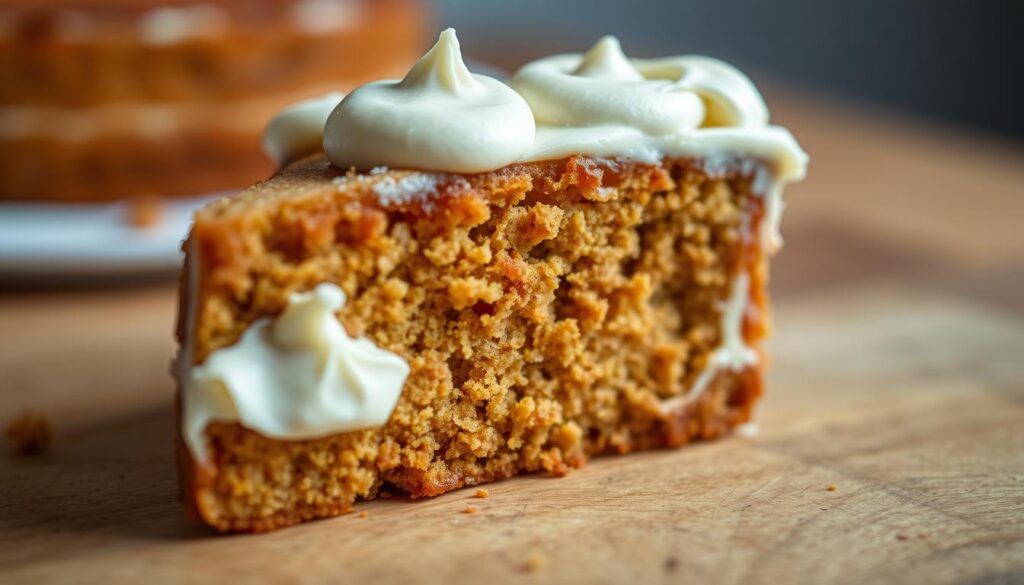
By using these tips, you can solve common problems and enjoy a moist carrot cake with great frosting.
Variations and Serving Suggestions
Carrot cake is very versatile, letting bakers try new flavors and ingredients. You can add crunch, change the recipe for dietary needs, or make it look better. There are many ways to do this.
Nuts, Raisins, and Pineapple Options
Walnuts or pecans add a nice crunch to carrot cake. Raisins and pineapple chunks also make it taste and feel better. Try different nuts or dried cranberries for a fruity twist.
Dietary Modifications
Carrot cake can be made gluten-free or vegan for those with dietary restrictions. Use almond flour or a gluten-free mix instead of regular flour. For vegan diets, replace eggs and milk with plant-based options. This way, everyone can enjoy this dessert.
Perfect Pairings and Presentation Ideas
Pairing carrot cake with coffee or tea makes it even better. Add vanilla ice cream or whipped cream for a special treat. Decorate with chopped nuts, shredded coconut, or edible flowers for a fancy look.
Trying out these variations and serving ideas can make your carrot cake unique. It’s perfect for any occasion or taste.
Conclusion: Enjoying Your Homemade Carrot Cake
Baking a homemade carrot cake is a rewarding experience. It ends in a deliciously moist and flavorful dessert. The joy of sharing it with loved ones adds to the satisfaction.
When you finish your carrot cake recipe, you start a new tradition. Sharing it with family and friends is a special moment. Every bite shows off your baking skills.
Your homemade carrot cake is perfect for any occasion. Whether at a gathering or with your morning coffee, it’s sure to make everyone smile. So, share your creations and enjoy the joy of baking something special.
FAQ
Does carrot cake need to be refrigerated?
Yes, carrot cake, especially with cream cheese frosting, should be refrigerated. This keeps it fresh and prevents spoilage.
Can I freeze carrot cake?
Yes, you can freeze carrot cake. It’s best to freeze it without the frosting. Then frost after thawing for the best results.
What is carrot cake made of?
Carrot cake is made of grated carrots, flour, sugar, eggs, butter or oil, and spices. It often includes walnuts or pecans and sometimes pineapple or raisins.
How long does carrot cake last in the fridge?
Carrot cake can last up to 5 days in the fridge. Store it in an airtight container for the longest freshness.
Is carrot cake gluten-free?
Traditional carrot cake is not gluten-free because it contains wheat flour. But, you can make a gluten-free version by using gluten-free flour.
Can I make carrot cake without nuts?
Yes, you can make carrot cake without nuts. Just omit them from the recipe or replace them with dried fruit.
How do I grate carrots for carrot cake?
Grate carrots using a box grater or a food processor with the shredding attachment. Grate them just before using for the best texture.
Can I use cake mix to make carrot cake?
Yes, you can use a cake mix to make carrot cake. Add grated carrots and other desired ingredients like nuts or spices to the mix.
What are some variations of carrot cake?
Variations include adding different nuts, using pineapple or raisins, making it gluten-free or vegan, and experimenting with various spices.
How do I prevent a soggy middle in carrot cake?
To prevent a soggy middle, ensure your cake is baked thoroughly. Check for doneness with a toothpick. Avoid overmixing the batter.
Can I make carrot cake without pineapple?
Yes, you can make carrot cake without pineapple. Pineapple adds moisture and flavor. You can substitute or omit it according to your preference.
What is the best cream cheese frosting recipe for carrot cake?
A classic cream cheese frosting is made with cream cheese, butter, vanilla extract, and powdered sugar. Beat until smooth. Adjust the consistency as needed.

